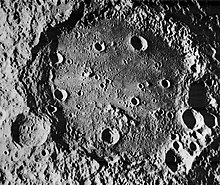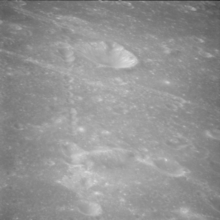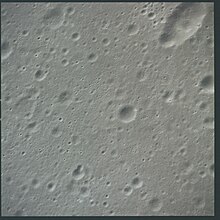
Anaxagoras is a young lunar impact crater that is located near the north pole of the Moon. It lies across the larger and more heavily worn crater Goldschmidt. To the south-southeast is Epigenes, and due south is the worn remains of Birmingham.

Zucchius is a prominent lunar impact crater located near the southwestern limb. Because of its location the crater appears oblong-shaped due to foreshortening. It lies just to the south-southwest of the crater Segner, and northeast of the much larger walled plain Bailly. To the southeast is Bettinus, a formation only slightly larger than Zucchius.
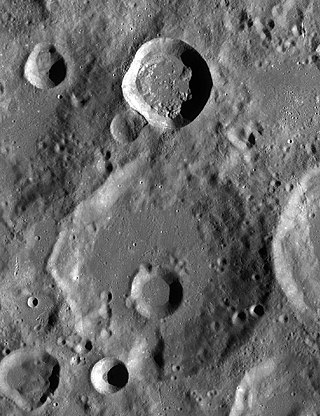
Zhukovskiy is a lunar impact crater that lies on the far side of the Moon. It forms a pair with Lebedinskiy, which is attached to the eastern rim. There are no other named craters of note in the immediate vicinity, although the immense walled plain Korolev lies farther to the southeast.

Humboldt is a large lunar impact crater that is located near the eastern limb of the Moon. Due to foreshortening this formation has an extremely oblong appearance. The actual shape of the crater is an irregular circle, with a significant indentation along the southeastern rim where the prominent crater Barnard intrudes. To the north-northwest of Humboldt is the large crater Hecataeus. Phillips is attached to the western rim. The rim of Humboldt is low, worn, and irregular in outline. The central peak forms a range on the crater floor. The floor surface contains a network of rilles forming a pattern of radial spokes and concentric arcs. There are also some dark patches located near the walls to the northeast, northwest, and southeast. There is a chain of craters leading from the northwest crater rim to a distance almost as long as the crater is wide. This formation is designated Catena Humboldt. Due to its location near the lunar limb, little detail was known about this crater until it was photographed by orbiting spacecraft.

Cleomedes is a prominent lunar impact crater located in the northeast part of the visible Moon, to the north of Mare Crisium. It was named after Greek astronomer Cleomedes. It is surrounded by rough ground with multiple crater impacts. The irregular crater Tralles intrudes into the northwest rim. To the east is Delmotte. North of Cleomedes is a triple-crater formation with Burckhardt occupying the center.
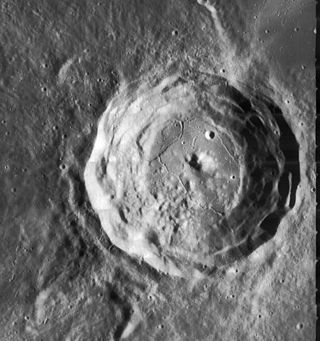
Cardanus is a lunar impact crater that is located in the western part of the Moon, in the western part of the Oceanus Procellarum. Due to its location the crater appears very oval because of foreshortening, and it is viewed almost from the side.

Eudoxus is a prominent lunar impact crater that lies to the east of the northern tip of the Montes Caucasus range. It is named after the Greek astronomer Eudoxus of Cnidus. It is located to the south of the prominent crater Aristoteles in the northern regions of the visible Moon. To the south is the ruined formation of Alexander, and the small crater Lamèch lies to the southwest.
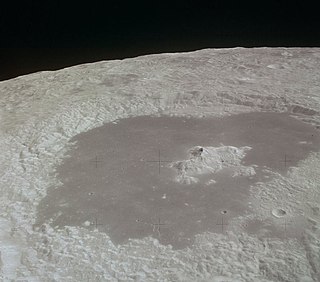
Tsiolkovskiy is a large lunar impact crater that is located on the far side of the Moon. Named for Russian scientist Konstantin Tsiolkovsky, it lies in the southern hemisphere, to the west of the large crater Gagarin, and northwest of Milne. Just to the south is Waterman, with Neujmin to the south-southwest. The crater protrudes into the neighbouring Fermi, an older crater of comparable size that does not have a lava-flooded floor.
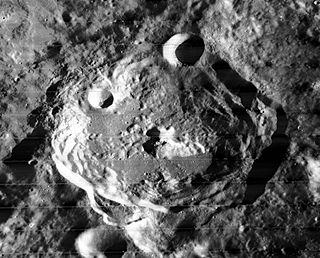
O'Day is a prominent lunar impact crater that is located on the far side of the Moon. It intrudes into the northwestern edge of Mare Ingenii, and the rim is lower on that side. To the northwest is the crater pair of Holetschek and Sierpinski. Southwest of O'Day lies the crater Seidel. It is named in honour of the American physicist Marcus O'Day.
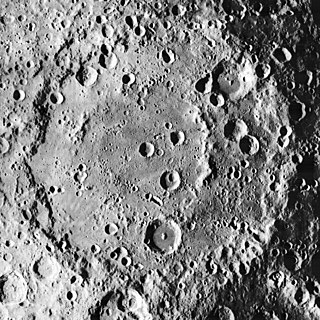
Korolev is a large lunar impact crater of the walled plain or basin type. It is a basin of Nectarian age.
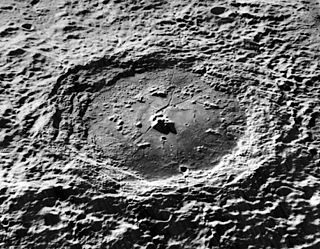
Compton is a prominent lunar impact crater that is located in the northern hemisphere on the far side of the Moon. It lies to the east of the Mare Humboldtianum, and southwest of the walled plain Schwarzschild. To the southeast of Compton is the heavily eroded crater Swann.

Epigenes is a lunar impact crater that is located in the north part of the Moon, and is sufficiently close to the northern limb to appear significantly foreshortened from the Earth. It lies just to the northwest of the remains of the walled plain W. Bond. Due north of Epigenes is Goldschmidt, and the ruined crater Birmingham lies just to the southwest.

Carnot is a large crater in the northern part of the Moon's far side. It was named after Nicolas L. S. Carnot by the IAU in 1970.

Inghirami is a lunar impact crater that is located toward the southwestern limb of the Moon. It lies to the southwest of the large walled plain Schickard. Northwest of Inghirami is the wide Vallis Inghirami, a wide, straight valley that is radial to the Mare Orientale impact basin. The valley has a length of about 140 kilometers and ends at the northern edge of the crater.

Chaplygin is a large lunar impact crater that lies on the far side of the Moon. It is located to the southeast of the huge walled plain Mendeleev, about midway between the craters Schliemann to the northeast and Marconi to the southwest. It is about the same size as Albategnius on the near side.

Fleming is a large lunar impact crater that is located on the Moon's far side, and cannot be seen from the Earth. It lies about a crater diameter to the east-northeast of Hertz, and to the northwest of Lobachevskiy.

Lebedinskiy is an impact crater on the far side of the Moon. It is attached to the eastern outer rim of the somewhat larger crater Zhukovskiy. About two crater diameters to the east-southeast lies the smaller Engel'gardt. The satellite crater Lebedinskiy P lies in the southern indentation of terrain between Lebedinskiy and Zhukovsky, and is nearly attached to the southwest rim of Lebedinskiy.

Van den Bos is a small lunar impact crater that is joined to the south-southwestern outer rim of the slightly larger crater Tamm. About one crater diameter to the west is Vil'ev. Farther away to the east is the prominent Chaplygin, and to the south-southwest lies Marconi. van den Bos is located on the far side of the Moon and cannot be viewed directly from the Earth.

Sechenov is a lunar impact crater on the far side of the Moon. It lies to the southwest of the huge walled plain Hertzsprung, and to the east-southeast of the crater Timiryazev. To the south-southeast of Sechenov lies Paschen.

Tamm is a shallow lunar impact crater. It is located to the west-northwest of the much larger and more prominent crater Chaplygin. Attached to the south-southwestern outer rim of Tamm is the smaller van den Bos. There is a gap in the southern rim where these two craters are joined together.

